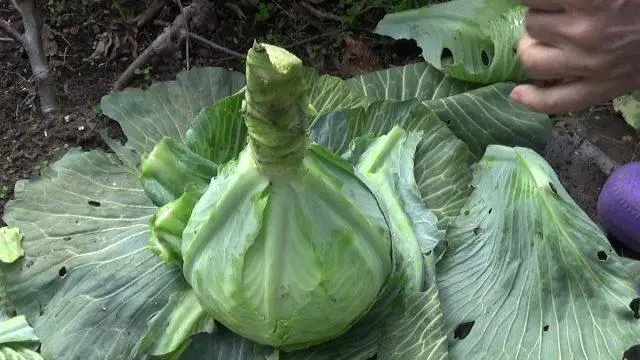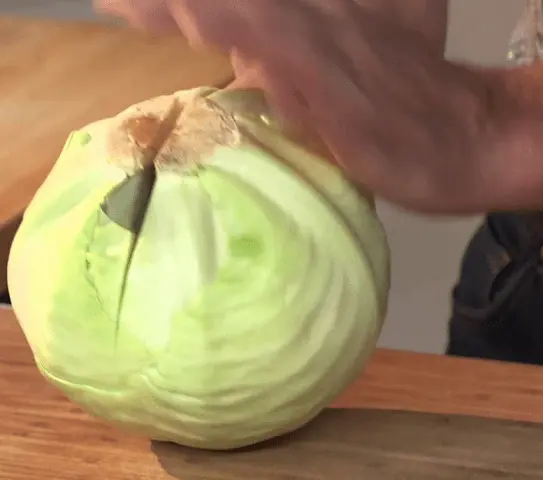Contents
The benefits and harms of cabbage stumps are associated with the chemical composition, as well as with the characteristics of cultivation. Quite a lot of substances accumulate in the core. But if the crop is obtained in your garden without the use of pesticides, you can not be afraid. Otherwise, it is recommended to use the core only in the spring.
Composition and calorie content
To understand the benefits or harms of a cabbage stalk, you need to find out what substances are included in its composition. These are vitamins, minerals and other valuable components: vitamins A, B groups (B1, B2, B6, B9), C, K, PP, potassium, chromium, zinc, phosphorus, magnesium, calcium, iron, cobalt, molybdenum, copper, antioxidants.
Nutritionists rightly consider the cabbage stalk a valuable product that provides much more benefit than harm. 100 g contains only 28 kcal. Nutritional value for the same weight:
- proteins – 1,8 g;
- fats – 0,1 g;
- carbohydrates – 5,4
What is useful stalk from white cabbage
Due to the rich chemical composition, the cabbage stalk has several useful properties:
- normalization of metabolism;
- enrichment with vitamins and minerals;
- decreased acidity of the stomach;
- help in the treatment of ulcers and gastritis;
- improvement in anemia;
- relief of asthma symptoms, as well as bronchitis;
- restoration of strength;
- help in the treatment of prostatitis, adenoma;
- improving brain function;
- increase in working capacity.
Is it possible to eat cabbage stalk
The stalk has been eaten for quite a long time. This is due to the fact that it was difficult to obtain cabbage seeds in the spring, so they ate last year’s stock until the beginning of summer. At the same time, the foliage was fermented separately, and the stalk was left in the cellar to be planted in April.

In order for the stump to bring maximum benefit and minimum harm, you can eat it only in small quantities.
Indeed, this part of the cabbage does not pose a particular threat to health. In addition, as already mentioned, it contains many useful substances. But you should not eat the core of ordinary store-bought cabbage, since it is probably grown using chemical fertilizers, pesticides and other substances. It is in the core that various compounds accumulate, including phosphates, nitrates. As a result, it can harm digestion.
Also, hand-bought cabbage core can do more harm than good. It is best to use only your crop, the quality of which you can be sure of. In this case, in any case, you should not give the core to children under 5-6 years old.
It should be borne in mind that in the first weeks or months after harvesting, the concentration of harmful substances, including nitrates, is maximum. However, over time, it decreases, so such a product already gives more benefit than harm. In spring, the nitrate content drops by 30%. Therefore, in March and April, the stump can be given to children, used for making salads, but only in moderation and not every day.
Is cabbage stalk harmful?
In general, the core of cabbage is not harmful to health, it has certain benefits. But in some cases it can be harmful. Substances in it are contained in high concentrations, which can lead to a number of side effects:
- diarrhea;
- feeling of heaviness in the abdomen;
- nausea, including vomiting;
- pain in the stomach.
You should not use the core in case of pancreatitis, increased intestinal motility, in the presence of internal bleeding in the stomach. Use with caution in diseases of the thyroid gland.
How to cut a stalk from a cabbage
To get as much benefit as possible and minimize harm, the core should be properly cut. To do this, take a sharp knife and act like this:
- Rinse the head of cabbage and, if necessary, remove all withered leaves.
- Cut off the stems that are at the bottom of the fork.
- Cut it in half from top to bottom. The cut must be clearly centered.
- Make an incision down.
- Further, at an angle, they pass along one side.
- Similarly, an incision is made on the other side – it turns out in the form of a “V”.
- Remove the core, continue to work with the leaves.

Make a cut in the middle
What can be cooked from cabbage stalks
Several dishes can be prepared from cabbage stalks. The easiest option is a vegetable salad. To do this, take:
- core – 1 pc.;
- carrots – 1 pcs .;
- leek – 10 cm (white fragment);
- garlic – 3 tooth;
- sunflower oil – 1 st. l .;
- cilantro – a bunch;
- rice vinegar – 1 tbsp. l.;
- soy sauce – 1 st. l .;
- a pinch of coriander.
To get more benefit and less harm, act like this:
- Carrots are cut into strips (as in Korean) or grated.
- Chop up the core.
- Next, chop the garlic and leek.
- Chop cilantro leaves.
- Add all other ingredients, a pinch of coriander and mix.
You can also make a side dish in the form of a stewed vegetable dish from a cabbage stalk. To obtain benefits and minimize harm, several components are taken at once:
- cores – 2-3 pcs.;
- carrots – 1 pcs .;
- sugar – 1 tsp;
- soy sauce – 1 tbsp. l .;
- red pepper – a pinch;
- sunflower oil – 2 tbsp. l.
- salt – to taste.
This is a Japanese style stew. It is low-calorie, so it really benefits and does no harm. During preparation, you should:
- Chop the carrot root into strips.
- After that, grind the stalk on a grater.
- Fry in sunflower oil (slightly above medium heat).
- Then add sugar, pepper, oil, salt, soy sauce.
- Mix everything and add some water.
- Cover with a lid, put on medium heat and simmer until fully cooked.
You can cook without water – then the vegetables are simply fried. They should become a little dry and have a light crust.
Conclusion
The benefits and harms of cabbage stumps have been well studied. In general, it should not be consumed due to the accumulation of hazardous substances. But if you eat in the spring or take a crop from your garden, there will definitely be more benefits than harm. It can be used both fresh and as part of various dishes.









